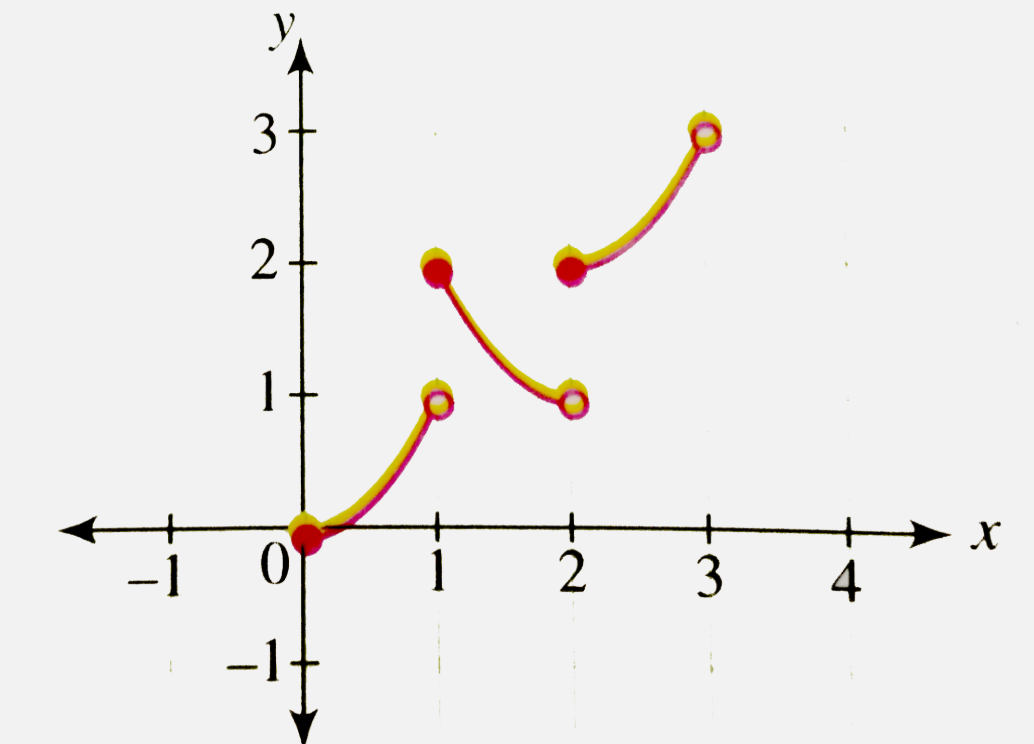Which of the following functions has (have) y-symmetry or origin symmetry?
(i) f(x)=x2sinx (ii)f(x)=log(1−x1+x)
(iii)f(x)=xex−1+x2+1 Solution in Tamil
(i) f(−x)=(−x)2sin(−x)=−x2sinx=−f(x), hence the function has origin symmetry
(ii) f(−x)=log(1−(−x)1+(−x))=log(1+x1−x)=−f(x)hence the function has origin symmetry
(iii) f(x)=xex−1+x2+1
⇒f(−x)=−xe−x−1−x2+1
=xexex−1−x2+1
=xex−x+xex−1−x2+1
=x+xex−1−x2+1
=xex−1+x2+1
= f(x)
Hence the function has y-symmetry.
Topper's Solved these Questions
- GETTING STARTED WITH GRAPHSBOOK - CENGAGECHAPTER - GETTING STARTED WITH GRAPHSEXERCISE - Exercise
18 Videos
- FUNCTIONSBOOK - CENGAGECHAPTER - FUNCTIONSEXERCISE - Question Bank
21 Videos
- GRAPH OF INVERSE TRIGONOMETRIC FUNCTIONSBOOK - CENGAGECHAPTER - GRAPH OF INVERSE TRIGONOMETRIC FUNCTIONSEXERCISE - Exercise
18 Videos
Similar Questions
Does the following graph pass the vertical or horizontal line test ?

View SolutionIf there are four distinct real numbers satisfying thẻ equation ∣∣x2−4x−7∣∣=n, then number of integers in the range of n is
View SolutionDraw the graph of y=tan−1x+cot−1x
View SolutionA function y=f(x) satisfies (x+1)f′(x)−2(x2+x)f(x)=(ex)2(x+1),∀x≻1. If f(0)=5, then f(x) is
View SolutionRange of the function f(x)=cos((ln(x^(2)+e))/(x^(2)+1))+sin(((ln(x^(2)+e))/(x^(2)+1))
View SolutionWhich of the following functions has (have) y-symmetry or origin symmetry?
(i) f(x)=x2sinx (ii)f(x)=log(x+√1+x2)
(iii)f(x)=ex+e−x2 (iv)f(x)={0, If x is rational 1, If x is irrational
View SolutionWhich of the following functions has (have) y-symmetry or origin symmetry?
(i) f(x)=x2sinx (ii)f(x)=log(1−x1+x)
(iii)f(x)=xex−1+x2+1
View SolutionDetermine whether the following functions are even or odd.
((i)f(x)=log(x+√1+x2),(ii)f(x)=x(ax+1ax−1)),((iii)f(x)=sinx+cosx,(iv)f(x)=x2−|x|),((v)f(x)=log(1−x1+x),(vi)f(x)={(sgnx)sgnx}n, n is an odd integer)
((vii)f(x)=sgn(x)+x2,),((viii)f(x+y)+f(x−y)=2f(x)⋅f(y), where f(0)≠0andx,y≠R.,)
View Solution(A) For each of the following function f(x), verify that: ∫20f(x)dx=∫10f(x)dx+∫21f(x)dx: (i) f(x)=x+2 (ii) f(x)=x2+2 (iii) f(x)=ex (B) For each of the following pairs of function f(x) and g(x), verify that: ∫10[f(x)+g(x)]dx=∫10f(x)dx+∫10g(x)dx: (i) f(x)=1,g(x) =x2 (ii) f(x)=ex,g(x)=1
View SolutionWhich of the following function is (are) even, odd, or neither? (a). f(x)=x2sinx (b). f(x)=log(1−x1+x) (c). f(x)=log(x+√1+x2) (d). f(x)=ex+e−x2
View SolutionCheck whether the function has (have) y-symmetry or origin symmetry: f(x)=x2sinx.
View SolutionDetermine whether the function has y-symmetry or origin symmetry : f(x)=xex−1+x2+1
View SolutionFor which of the following functions f(0) exists such that f(x) is continuous at f(x)=1(log)e|x| b. f(x)=1(log)e|x| c. f(x)=x sinpi/x d. f(x)=11+2cotx
View SolutionFind the domains of definaton of the following functions:
(a) f(x)=√x−1+√6−x
(b) f(x)=√x2−x−2+1√3+2x−x2
(c) f(x)=x√(x2−x−2)
(d) f(x)=√sinx−1
(e) f(x)=√log5x−x24,
(f) f(x)=logx5,
(g) f(x)=logx2−5x+6x2+4x+6
(h) f(x)=arcsinx−32−log(4−x)
(i) f(x)=1log(1−x)+√x+2,
(j) f(x)=logcosx,
(k)f(x)=arccos34+2sinx
(l) y=1√|x|−x
View SolutionDetermine whether the following functions are even or odd.
((i)f(x)=log(x+√1+x2),(ii)f(x)=x(ax+1ax−1)),((iii)f(x)=sinx+cosx,(iv)f(x)=x2−|x|),((v)f(x)=log(1−x1+x),(vi)f(x)={(sgnx)sgnx}n, n is an odd integer)
((vii)f(x)=sgn(x)+x2,),((viii)f(x+y)+f(x−y)=2f(x)⋅f(y), where f(0)≠0andx,y≠R.,)
View Solution
